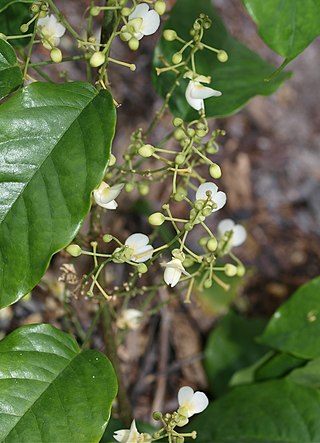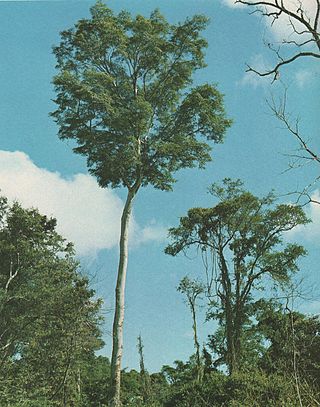
Camoensia is a genus of 2 species of lianas in the family Fabaceae, subfamily Faboideae, native to the Gulf of Guinea, Africa. C. scandens is cultivated as an ornamental plant; it has one of the largest leguminous flowers, up to 20 cm across. The genus has classically been assigned to the tribe Sophoreae, but was recently assigned to its own monophyletic tribe, Camoensieae, on the basis of molecular phylogenetic evidence. Species of Camoensia are known to produce quinolizidine alkaloids, consistent with their placement in the genistoid clade.

Baphia is a small genus of legumes that bear simple leaves. Baphia is from the Greek word βάπτω, referring to a red dye that is extracted from the heartwood of tropical species. The genus is restricted to the African tropics. Baphia was traditionally assigned to the tribe Sophoreae; however, recent molecular phylogenetic analyses reassigned Baphia to the tribe Baphieae.

Airyantha is a small genus of flowering plants in the legume family, Fabaceae. It belongs to the subfamily Faboideae. It was named after the botanist Herbert Kenneth Airy Shaw. It was traditionally assigned to the tribe Sophoreae; however, recent molecular phylogenetic analyses reassigned Airyantha into the Baphieae tribe.

Amphimas is a small genus of flowering plants in the legume family, Fabaceae. It belongs to the subfamily Faboideae. It is a west African tree used for medicine and for wood. Amphimas was traditionally assigned to the tribe Sophoreae; however, recent molecular phylogenetic analyses reassigned Amphimas into an unspecified position in the Meso-Papilionoideae.
Baphiopsis parviflora is an African species of flowering plants in the legume family, Fabaceae. It is the sole species in genus Baphiopsis. It is a shrub or tree which ranges from Cameroon to Tanzania and Angola.
Dalhousiea is a genus of flowering plants in the legume family, Fabaceae. It belongs to the subfamily Faboideae. It was named by Robert Graham after James Andrew Ramsey the 10th Earl of Dalhousie or alternatively after George Ramsay, 9th Earl of Dalhousie and Christian Ramsay, Countess of Dalhousie, for her work in the classification of Indian botany. Dalhousiea was traditionally assigned to the tribe Sophoreae; however, recent molecular phylogenetic analyses reassigned Dalhousiea into the Baphieae tribe.
Leucomphalos is a genus of flowering plants in the legume family, found in west Africa. It belongs to the subfamily Faboideae. Leucomphalos was traditionally assigned to the tribe Sophoreae; however, recent molecular phylogenetic analyses reassigned Leucomphalos to the Baphieae tribe.

Luetzelburgia is a genus of flowering plants in the legume family, Fabaceae. It belongs to the subfamily Faboideae. It was traditionally assigned to the tribe Sophoreae, mainly on the basis of flower morphology; recent molecular phylogenetic analyses assigned Luetzelburgia into an informal, monophyletic clade called the "vataireoids". Keys for the different species of Luetzelburgia have been published.
Sweetia fruticosa is a species of flowering plants in the legume family, Fabaceae and is the only member of the genus Sweetia. It belongs to the subfamily Faboideae. It was traditionally assigned to the tribe Sophoreae, mainly on the basis of flower morphology; recent molecular phylogenetic analyses assigned Sweetia fruticosa into an informal, monophyletic clade called the "vataireoids".
Vataireopsis is a genus of flowering plants in the legume family, Fabaceae. It belongs to the subfamily Faboideae. It was traditionally assigned to the tribe Dalbergieae, mainly on the basis of flower morphology; recent molecular phylogenetic analyses assigned Vataireopsis into an informal, monophyletic clade called the "vataireoids".

The tribe Dipterygeae is one of the subdivisions of the plant family Fabaceae. It was recently recircumscribed to include the following genera:

The tribe Sophoreae is one of the subdivisions of the plant family Fabaceae. Traditionally this tribe has been used as a wastebasket taxon to accommodate genera of Faboideae which exhibit actinomorphic, rather than zygomorphic floral symmetry and/or incompletely differentiated petals and free stamens. Various morphological and molecular analyses indicated that Sophoreae as traditionally circumscribed was polyphyletic. This led to a re-circumscription of Sophoreae, which resulted in the transfer of many genera to other tribes. This also necessitated the inclusion of two former tribes, Euchresteae and Thermopsideae, in the new definition of Sophoreae. Tribe Sophoreae, as currently circumscribed, consistently forms a monophyletic clade in molecular phylogenetic analyses. The Sophoreae arose 40.8 ± 2.4 million years ago.

The vataireoids are an early-branching monophyletic clade of the flowering plant subfamily Faboideae that are mostly found in northern South America, primarily Brazil.

The non-protein amino acid-accumulating clade, also known as the Canavanine-accumulating clade is a clade of the flowering plant subfamily Faboideae that includes the majority of agriculturally-cultivated legumes. It is characterized by the accumulation of the non-proteinogenic amino acid canavanine in the seeds—a deterrent against herbivory. This phylogenetic trait was first recognized in the early 1980s. This clade is consistently resolved in molecular phylogenies. It contains many economically important genera, including Cicer, Glycine, Medicago, Phaseolus, Trifolium, Vicia, and Vigna.

The tribe Amburaneae is one of the subdivisions of the plant family Fabaceae. It has been circumscribed to include the following genera, which used to be placed in tribes Sophoreae and Swartzieae:
The Andira clade is a predominantly Neotropical, monophyletic clade of the flowering plant subfamily Faboideae. The members of this clade were formerly included in tribe Dalbergieae, but this placement was questioned due to differences in wood anatomy and fruit, seed, seedling, floral, and vegetative characters. Recent molecular phylogenetic evidence has shown that they belong to a unique evolutionary lineage. It is predicted to have diverged from the other legume lineages in the late Eocene).
The tribe Ormosieae is one of the subdivisions of the plant family Fabaceae, primarily found in tropical regions of the Americas, but also in southeast Asia and northern Australia. The members of this tribe were formerly included in tribe Sophoreae, but were recently circumscribed into a new tribe. The members of this tribe consistently form a monophyletic clade in molecular phylogenetic analyses. The tribe does not currently have a node-based definition, but morphological synapomorphies have been tentatively identified: "mostly dehiscent pods with woody valves" and "tufts of minute colleter-like glands in the axils of bract and bracteoles". Like other genistoids, members of tribe Ormosieae are known to produce quinolizidine alkaloids.

The Genistoids are one of the major radiations in the plant family Fabaceae. Members of this phylogenetic clade are primarily found in the Southern hemisphere. Some genera are pollinated by birds. The genistoid clade is consistently resolved as monophyletic in molecular phylogenetic analyses. It is estimated to have arisen 56.4 ± 0.2 million years ago. A node-based definition for the genistoids is: "the MRCA of Poecilanthe parviflora and Lupinus argenteus." One morphological synapomorphy has been tentatively identified: production of quinolizidine alkaloids. Some genera also accumulate pyrrolizidine. A new genus, to be segregated from Clathrotropis, has also been proposed to occupy an undetermined position within the genistoid clade.

The tribe Baphieae is one of the subdivisions of the plant family Fabaceae. The Baphieae tribe arose 55.3 ± 0.4 million years ago.
Bowringia is a genus of flowering plants in the legume family (Fabaceae), found in tropical Africa and southeastern Asia. It includes four species native to western and central Africa and Madagascar, and to Borneo, Indochina, and southern China.










